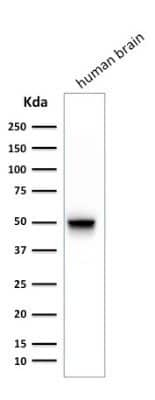GFAP Antibody (SPM248) - Azide and BSA Free
Novus Biologicals, part of Bio-Techne | Catalog # NBP2-34401


Conjugate
Catalog #
Key Product Details
Species Reactivity
Validated:
Human, Mouse, Rat, Porcine, Bovine, Chicken, Rabbit
Applications
CyTOF-ready, Flow Cytometry, Immunocytochemistry/Immunofluorescence, Immunohistochemistry, Immunohistochemistry-Paraffin, Western Blot
Label
Unconjugated
Antibody Source
Monoclonal Mouse IgG1 kappa Clone # SPM248
Format
Azide and BSA Free
Concentration
1.0 mg/ml
Product Summary for GFAP Antibody (SPM248) - Azide and BSA Free
Immunogen
GFAP isolated from pig spinal cord (Uniprot: P14136)
Localization
Cytoplasmic
Specificity
This monoclonal antibody recognizes a protein of ~50kDa which is identified as Glial Fibrillary Acidic Protein (GFAP). It shows no cross-reaction with other intermediate filament proteins. GFAP is specifically found in astroglia. GFAP is a very popular marker for localizing benign astrocyte and neoplastic cells of glial origin in the central nervous system. Antibody to GFAP is useful in differentiating primary gliomas from metastatic lesions in the brain and for documenting astrocytic differentiation in tumors outside the CNS.
Marker
Astrocyte & Neural Stem Cell Marker
Clonality
Monoclonal
Host
Mouse
Isotype
IgG1 kappa
Theoretical MW
50 kDa.
Disclaimer note: The observed molecular weight of the protein may vary from the listed predicted molecular weight due to post translational modifications, post translation cleavages, relative charges, and other experimental factors.
Disclaimer note: The observed molecular weight of the protein may vary from the listed predicted molecular weight due to post translational modifications, post translation cleavages, relative charges, and other experimental factors.
Description
1.0 mg/ml of antibody purified from Bioreactor Concentrate by Protein A/G. Prepared in 10mM PBS WITHOUT BSA & azide. Also available at 200 ug/ml WITH BSA & azide (NBP2-34353).
Antibody with azide - store at 2 to 8C. Antibody without azide - store at -20 to -80C. Antibody is stable for 24 months. Non-hazardous.
Antibody with azide - store at 2 to 8C. Antibody without azide - store at -20 to -80C. Antibody is stable for 24 months. Non-hazardous.
Scientific Data Images for GFAP Antibody (SPM248) - Azide and BSA Free
Western Blot: GFAP Antibody (SPM248) - Azide and BSA Free [NBP2-34401] - Western Blot Analysis of human brain tissue lysate using GFAP Antibody (SPM248).
Immunohistochemistry-Paraffin: GFAP Antibody (SPM248) - Azide and BSA Free [NBP2-34401] - Formalin-fixed, paraffin-embedded human Schwannoma stained with GFAP monoclonal antibody (SPM248)
Flow Cytometry: GFAP Antibody (SPM248) - Azide and BSA Free [NBP2-34401] - Flow Cytometric Analysis of T98G cells using GFAP Antibody (SPM248) followed by Goat anti-Mouse IgG-CF488 (Blue); Isotype Control (Red).
Applications for GFAP Antibody (SPM248) - Azide and BSA Free
Application
Recommended Usage
Flow Cytometry
0.5 - 1 ug/million cells
Immunocytochemistry/Immunofluorescence
1 - 2 ug/mL
Immunohistochemistry-Paraffin
0.5 - 1 ug/mL
Western Blot
0.5 - 1 ug/mL
Application Notes
Immunohistochemistry (Formalin-fixed): 1-2 ug/mL for 30 minutes at RT. Staining of formalin-fixed tissues requires heating tissue sections in 10 mM Tris with 1mM EDTA, pH 9.0, for 45 min at 95C followed by cooling at RT for 20 minutes.
Optimal dilution for a specific application should be determined.
Optimal dilution for a specific application should be determined.
Please Note: Optimal dilutions of this antibody should be experimentally determined.
Formulation, Preparation, and Storage
Purification
Protein A or G purified
Formulation
10 mM PBS
Format
Azide and BSA Free
Preservative
No Preservative
Concentration
1.0 mg/ml
Shipping
The product is shipped with polar packs. Upon receipt, store it immediately at the temperature recommended below.
Stability & Storage
Store at -20 to -80C. Avoid freeze-thaw cycles.
Background: GFAP
An increase in GFAP levels is often associated with neuroinflammation which results in the activation and proliferation of astroglia cell population (1,2). GFAP expression is also observed in brains of patients with neurodegenerative diseases including Alzheimer's and Parkinson's, epilepsy disorders, and brain injuries (1-4). Lesion sites associated with neurodegeneration can exhibit an array of gliosis characteristics from glial scarring with reduced astrocyte proliferation to activated, GFAP-positive astrocytes surrounding amyloid plaques (2). Furthermore, the GFAP gene is a target of single nucleotide polymorphisms in the coding region, considered a gain-of-function mutation, characterized by astrocytic inclusions, termed Rosenthal fibers, resulting in Alexander Disease (1-4). GFAP is also a center of many post-translational modifications, such as phosphorylation, which can alter various aspects of filament assembly (1,4).
References
1. Yang, Z., & Wang, K. K. (2015). Glial fibrillary acidic protein: from intermediate filament assembly and gliosis to neurobiomarker. Trends in Neurosciences. https://doi.org/10.1016/j.tins.2015.04.003
2. Hol, E. M., & Capetanaki, Y. (2017). Type III Intermediate Filaments Desmin, Glial Fibrillary Acidic Protein (GFAP), Vimentin, and Peripherin. Cold Spring Harbor Perspectives in Biology. https://doi.org/10.1101/cshperspect.a021642
3. Potokar, M., Morita, M., Wiche, G., & Jorgacevski, J. (2020). The Diversity of Intermediate Filaments in Astrocytes. Cells. https://doi.org/10.3390/cells9071604
4. Viedma-Poyatos, a., Pajares, M. A., & Perez-Sala, D. (2020). Type III intermediate filaments as targets and effectors of electrophiles and oxidants. Redox Biology. https://doi.org/10.1016/j.redox.2020.101582
Long Name
Glial Fibrillary Acidic Protein
Alternate Names
ALXDRD, FLJ45472, GFAP, GFAP astrocytes, glial fibrillary acidic protein
Gene Symbol
GFAP
UniProt
Additional GFAP Products
Product Documents for GFAP Antibody (SPM248) - Azide and BSA Free
Product Specific Notices for GFAP Antibody (SPM248) - Azide and BSA Free
This product is for research use only and is not approved for use in humans or in clinical diagnosis. Primary Antibodies are guaranteed for 1 year from date of receipt.
